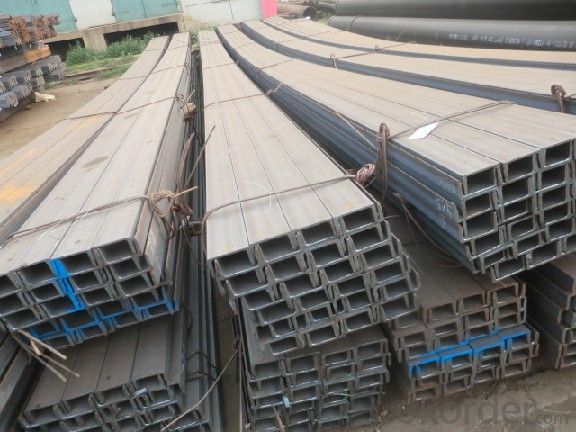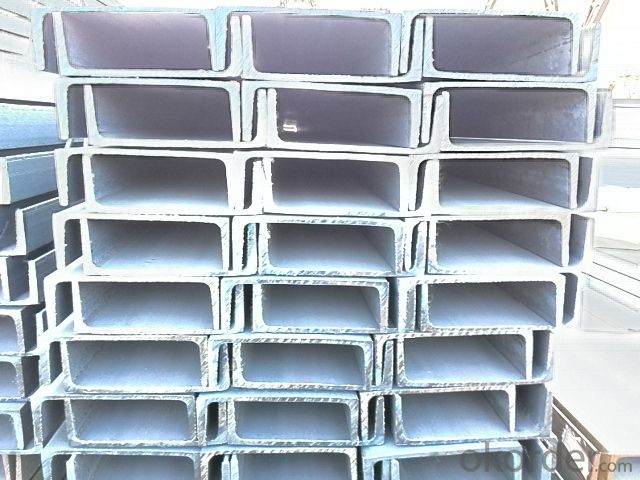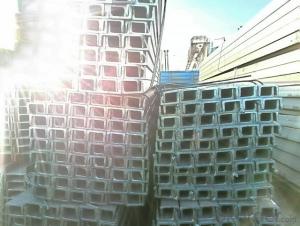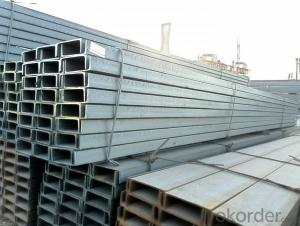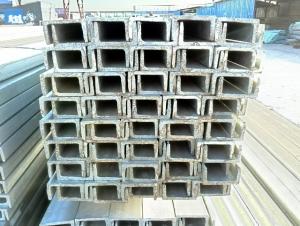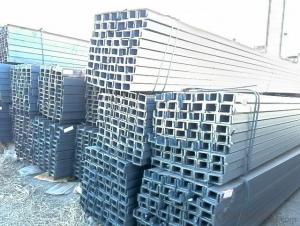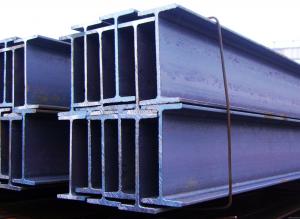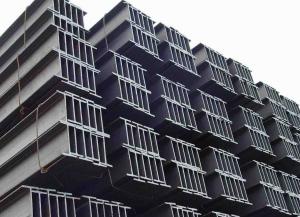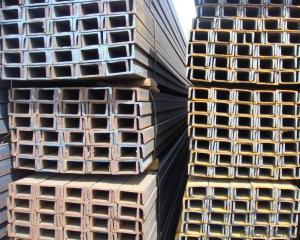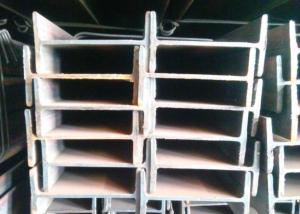JIS U-Channel Beams with Competitive Price
- Loading Port:
- Tianjin
- Payment Terms:
- TT OR LC
- Min Order Qty:
- 25 m.t.
- Supply Capability:
- 10000 m.t./month
OKorder Service Pledge
OKorder Financial Service
You Might Also Like
Product Description:
| Minimum Order Quantity: | 25MT | Unit: | m.t. | Loading Port: | Xingang Port |
| Supply Ability: | 120000TON/Year | Payment Terms: | TT or LC |
Product Applications:
Japanese Standard U-channels are ideal for structural applications and are widely used in the construction of buildings and bridges, and the manufacturing, petrochemical, and transportation industries.
Product Advantages:
OKorder's Japanese Standard U-channels are durable, strong, and resist corrosion.
Main Product Features:
· Premium quality
· Prompt delivery & seaworthy packing (30 days after receiving deposit)
· Corrosion resistance
· Can be recycled and reused
· Mill test certification
· Professional Service
· Competitive pricing
Product Specifications:
Manufacture: Hot rolled
Grade: Q195 – 235
Certificates: ISO, SGS, BV, CIQ
Length: 6m – 12m, as per customer request
Packaging: Export packing, nude packing, bundled
1. We are definitely speciallizing in manufacturing and supplying channel steel as per japanese standard, which is characterised with high mechanical strength and competitive prices.
Original Place | Tangshan, China | Brand Name | UINDA |
Standard | JIS G3192 : 1990 | ||
Material Grade | SS490 | ||
Sizes | 50mm to 200mm | ||
Sales Volume/Year | 3000MT | ||
Destination Area | Middle East, Africa, Southeast Asia | ||
2. The sections in details are as followings in the table-1
JIS U CHANNEL | Standard | Sectional | Dimension |
| Mass: |
| (mm) | (mm) | (mm) | (mm) |
|
50x25 | 50 | 25 | 3.0 | 6.00 | 2.37 |
75X40 | 75 | 40 | 3.8 | 7.00 | 5.30 |
75X40 | 75 | 40 | 4.0 | 7.00 | 5.60 |
75X40 | 75 | 40 | 4.5 | 7.00 | 5.85 |
75X40 | 75 | 40 | 5.0 | 7.00 | 6.92 |
|
|
|
|
|
|
100X50 | 100 | 50 | 3.8 | 6.00 | 7.30 |
100X50 | 100 | 50 | 4.2 | 6.00 | 8.03 |
100X50 | 100 | 50 | 4.5 | 7.50 | 8.97 |
100X50 | 100 | 50 | 5.0 | 7.50 | 9.36 |
|
|
|
|
|
|
125X65 | 125 | 65 | 5.2 | 6.80 | 11.66 |
125X65 | 125 | 65 | 5.3 | 6.80 | 12.17 |
125X65 | 125 | 65 | 5.5 | 8.00 | 12.91 |
125X65 | 125 | 65 | 6.0 | 8.00 | 13.40 |
|
|
|
|
|
|
150x75 | 150 | 75 | 5.5 | 7.30 | 14.66 |
150x75 | 150 | 75 | 5.7 | 10.00 | 16.71 |
150x75 | 150 | 75 | 6.0 | 10.00 | 17.90 |
150x75 | 150 | 75 | 6.5 | 10.00 | 18.60 |
150x75 | 150 | 75 | 6.5 | 10.00 | 24.00 |
|
|
|
|
|
|
200X80 | 200 | 80 | 7.5 | 11.00 | 24.60 |
Table-1
3. The mechanical property of JIS U Channel Steel in the table-2:
Grade | Yield Strength,N/mm² | Extension Strength N/mm² | |||
Thickness of Steel,mm | |||||
≦16 | >16-≦40 | >40-≦100 | >100 | ||
SS490 | ≧285 | ≧275 | ≧255 | ≧245 | 490-610 |
Table-2
4. The chemical composition of JIS U Channel Steel as per SS490 in the table-3
Grade | Element(%) | |||
C | Mn | P | S | |
SS490 | - | - | ≦0.050 | ≦0.050 |
Table-3
FAQ:
Q1: Why buy Materials & Equipment from OKorder.com?
A1: All products offered byOKorder.com are carefully selected from China's most reliable manufacturing enterprises. Through its ISO certifications, OKorder.com adheres to the highest standards and a commitment to supply chain safety and customer satisfaction.
Q2: How do we guarantee the quality of our products?
A2: We have established an advanced quality management system which conducts strict quality tests at every step, from raw materials to the final product. At the same time, we provide extensive follow-up service assurances as required.
Q3: The products are invoicing on theoritical weight or on actual weight?
A3: We can do it in both manners, according to the customers' request.
Images:
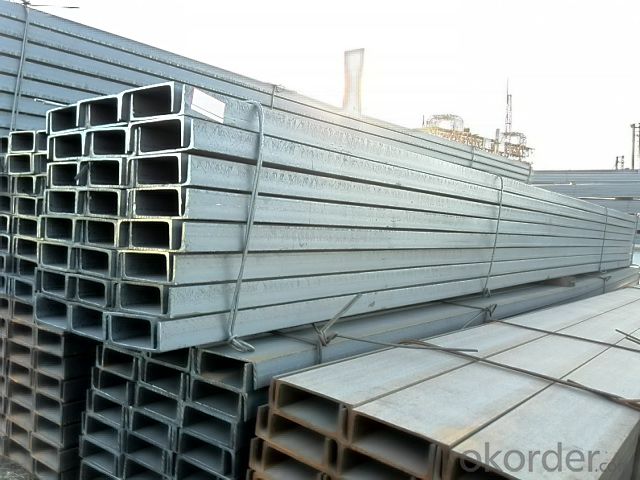
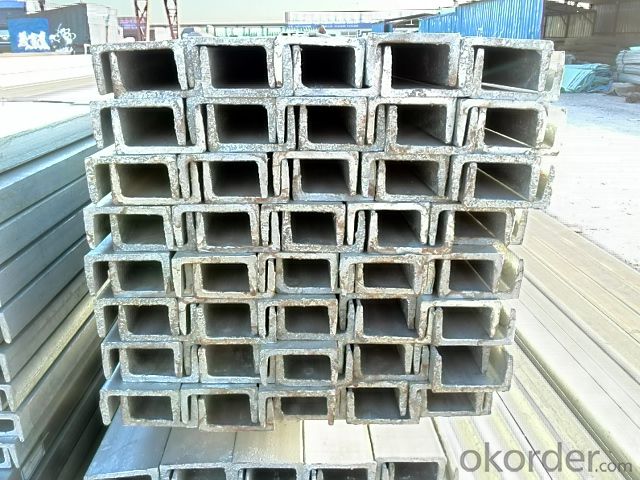
- Q: What are the different types of connections used for steel I-beams in seismic areas?
- In seismic areas, steel I-beams commonly use different types of connections to ensure structural stability and prevent damage during earthquakes. Some of the commonly employed connections include bolted connections, welded connections, and moment-resisting connections. Bolted connections involve using bolts to connect the beams to other structural elements, providing flexibility and ease of installation. Welded connections involve fusing the beams together using heat and creating a strong, continuous connection. Moment-resisting connections are designed to resist the rotational forces generated during an earthquake and often utilize a combination of bolts and welds to provide enhanced strength and rigidity. These various types of connections are engineered to meet specific seismic design requirements and ensure the safety and performance of steel I-beam structures.
- Q: Can steel I-beams be used in mezzanine or elevated platform construction?
- Yes, steel I-beams can be used in mezzanine or elevated platform construction. Steel I-beams are commonly used in construction due to their strength and structural integrity. They provide excellent support and stability for mezzanine and elevated platform structures. Steel I-beams can be designed and installed to meet the specific load requirements and architectural design of the project. They are versatile and can be used in a variety of construction applications, including mezzanines and elevated platforms.
- Q: Can Steel I-Beams be used for educational institutions like schools or universities?
- Yes, Steel I-Beams can be used for educational institutions like schools or universities. Steel I-Beams are commonly used in construction due to their structural strength and durability. They provide a stable framework for large buildings, making them suitable for educational institutions that require spacious and long-lasting structures. Additionally, steel I-beams can support heavy loads, making them ideal for constructing multi-story buildings or auditoriums within educational campuses.
- Q: What are the fire resistance properties of steel I-beams?
- Steel I-beams have excellent fire resistance properties. Due to their inherent material properties and structural design, steel I-beams are highly resistant to fire and can withstand high temperatures for extended periods of time. The fire resistance of steel I-beams is primarily due to the low thermal conductivity of steel. This means that steel does not conduct heat easily, thereby reducing the spread of fire within the structure. Additionally, steel has a high melting point, typically around 1370 degrees Celsius (2500 degrees Fahrenheit), which allows it to maintain its structural integrity even at high temperatures. Moreover, the I-beam design of steel beams provides added fire resistance. The shape of the I-beam allows for a greater surface area exposed to the fire, which helps dissipate heat more efficiently. This helps to prevent localized hot spots and further enhances the overall fire resistance of the steel beams. In case of a fire, steel I-beams can also resist the effects of thermal expansion and contraction. As the temperature rises, steel expands, but due to its high tensile strength and rigidity, it can withstand these thermal stresses without significant structural deformation. Furthermore, steel beams can be protected with additional fire-resistant materials, such as fireproof coatings or intumescent paints, to further enhance their fire resistance. These coatings create a protective barrier that insulates the steel from the heat of the fire, delaying the increase in temperature and providing additional time for evacuation or firefighting efforts. Overall, steel I-beams have excellent fire resistance properties, making them a popular choice for structural applications in buildings and other fire-prone environments. Their ability to withstand high temperatures, low thermal conductivity, and the I-beam design contribute to their superior fire resistance capabilities, ensuring the safety and stability of structures in the event of a fire.
- Q: Do steel I-beams have any aesthetic applications in architecture?
- Indeed, aesthetic applications in architecture can be achieved through the use of steel I-beams. Although their primary function is structural, thanks to their strength and load-bearing capabilities, they can also contribute to the visual appeal and modern aesthetic of a building's design. By incorporating exposed steel I-beams, the sleek and industrial appearance of these elements can become a prominent feature in architectural compositions. This approach is particularly effective in contemporary and industrial style buildings, where the desire for the raw and rugged aesthetic of steel is prevalent. Furthermore, the utilization of steel I-beams allows for open and expansive interior spaces, enabling large and uninterrupted spans that create a sense of openness and modernity. Ultimately, steel I-beams can be used in a creative manner in architecture, not only meeting structural requirements but also adding aesthetic value to the overall design of a building.
- Q: What are the common fabrication methods for steel I-beams?
- Steel I-beams can be fabricated using several common methods. The first method, hot rolling, is widely used. It involves heating a large steel billet and gradually shaping it into the desired I-beam profile by passing it through a series of rollers. This method ensures excellent structural integrity and dimensional accuracy. Another commonly used method is welding. By cutting and welding together steel plates or sections, the I-beam shape is created. This method allows for greater customization flexibility and can be used for both small-scale and large-scale production. Cold forming is a method where steel sheets or strips are bent and shaped into the I-beam shape through cold-rolling or using press brakes or roll forming machines. This method is often employed for smaller or lightweight I-beams. Extrusion, although less common, is used for specialized applications that require complex shapes or unique profiles. It involves forcing molten steel through a die to create the desired I-beam shape. In summary, these fabrication methods offer various options for manufacturing steel I-beams, enabling customization according to specific project requirements. Each method presents its own advantages and considerations, such as cost, production volume, and desired product properties.
- Q: Can steel I-beams be used for curtain wall systems?
- Indeed, curtain wall systems can make use of steel I-beams. In commercial buildings, these systems are usually employed to offer an external façade and bear the weight of the structure. Steel I-beams are a popular choice for curtain wall systems due to their exceptional load-bearing capacities and ability to withstand the forces exerted on the building. They provide structural support and can be tailored to accommodate the weight of curtain wall panels, glass, and other elements. Furthermore, steel I-beams possess durability and resilience against various weather conditions, rendering them appropriate for application in curtain wall systems.
- Q: How do steel I-beams contribute to the overall stability of a structure?
- Steel I-beams contribute to the overall stability of a structure by their strength and load-bearing capacity. Their shape allows them to distribute and transfer the weight of the structure evenly, minimizing the risk of structural failure or collapse. Additionally, their high tensile strength provides resistance against bending or buckling, ensuring the stability and durability of the overall structure.
- Q: What are the different types of steel connections for I-beams?
- Different types of steel connections are available for I-beams, each serving a specific purpose and offering unique advantages. Some commonly used steel connections for I-beams include the following: 1. I-beams can be connected using welding, which involves melting the metal surfaces and joining them with a filler material. Welded connections provide excellent strength and stiffness, making them suitable for heavy-duty applications. 2. Bolted connections involve using bolts, nuts, and washers to secure the I-beams together. This type of connection offers flexibility as it allows for disassembly and reassembly, making it ideal for situations that require easy maintenance or modification. 3. Riveted connections use rivets to connect I-beams. This method involves drilling holes through the flanges and webs of the beams and inserting rivets to hold them together. Riveted connections are known for their high strength and durability, making them suitable for structural applications. 4. Pinned connections use pins to connect the I-beams. This type of connection allows for rotational movement between the beams, making it suitable for situations where flexibility and movement are required, such as in trusses or roof structures. 5. Moment connections are designed to transfer bending moments between I-beams. These connections are typically used in structures where a high level of rigidity is required, such as in multi-story buildings or bridges. Moment connections can be either welded or bolted, depending on the specific application. 6. Splice connections are used to join two I-beams together to create longer beams. This type of connection is often used when longer lengths of beams are required but cannot be obtained in a single piece. Splice connections can be welded, bolted, or riveted, depending on the design requirements. It's important to consider various factors, such as structural requirements, load-bearing capacity, ease of installation, and maintenance considerations, when choosing a steel connection for I-beams. Consulting with a structural engineer or steel fabrication specialist is recommended to determine the most suitable connection type for a specific application.
- Q: Can steel I-beams be used for pedestrian bridges or walkways?
- Yes, steel I-beams can be used for pedestrian bridges or walkways. Steel I-beams are commonly used in construction due to their strength and load-bearing capabilities. They are capable of supporting heavy loads, making them suitable for pedestrian bridges. Additionally, steel is a durable material that can withstand various weather conditions and has a long lifespan. Steel I-beams can be designed to meet the specific requirements of pedestrian bridges or walkways, ensuring safety and stability for pedestrians.
Send your message to us
JIS U-Channel Beams with Competitive Price
- Loading Port:
- Tianjin
- Payment Terms:
- TT OR LC
- Min Order Qty:
- 25 m.t.
- Supply Capability:
- 10000 m.t./month
OKorder Service Pledge
OKorder Financial Service
Similar products
Hot products
Hot Searches
Related keywords



